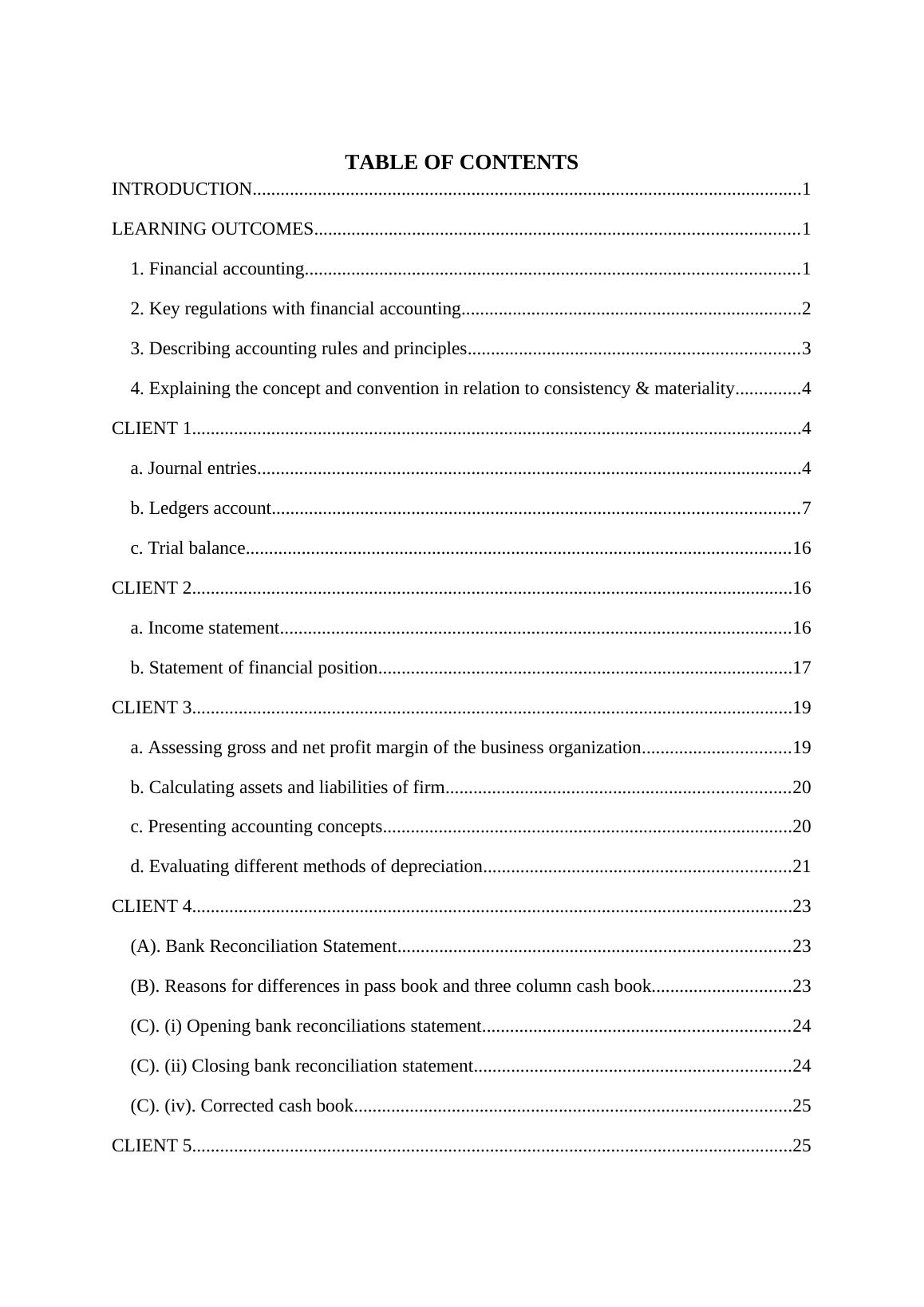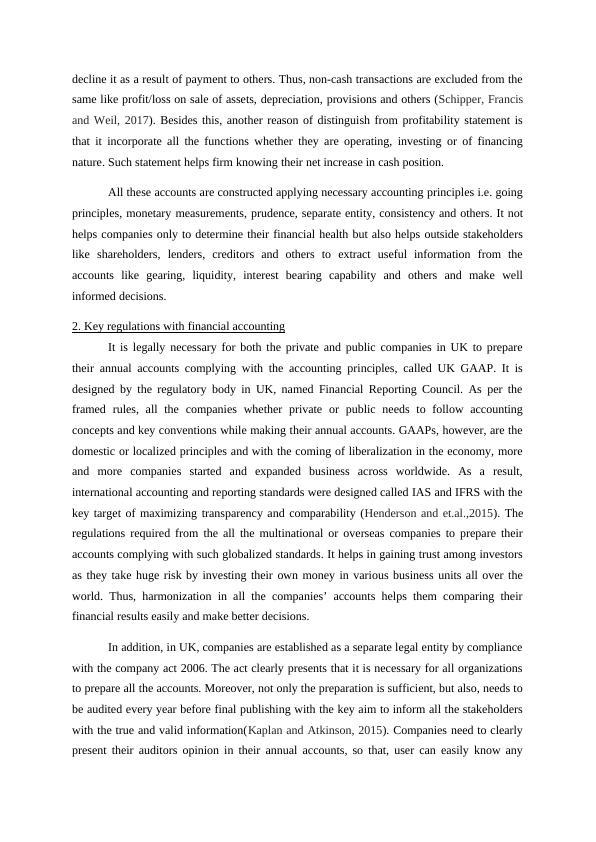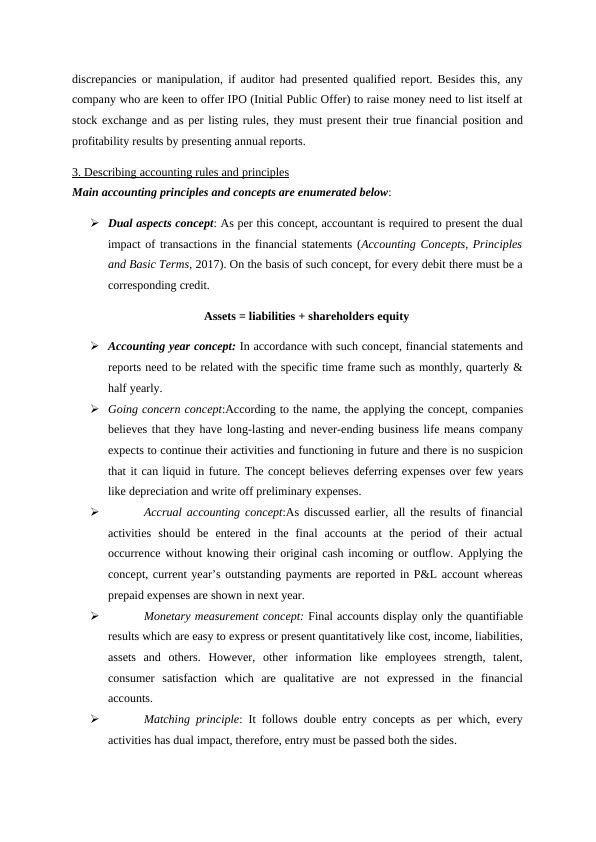Report on Accounting, Depreciation, Suspense and Clearance Account
Added on 2020-06-03
33 Pages4290 Words229 Views
Financial Accounting

TABLE OF CONTENTSINTRODUCTION......................................................................................................................1LEARNING OUTCOMES........................................................................................................11. Financial accounting..........................................................................................................12. Key regulations with financial accounting.........................................................................23. Describing accounting rules and principles.......................................................................34. Explaining the concept and convention in relation to consistency & materiality..............4CLIENT 1...................................................................................................................................4a. Journal entries.....................................................................................................................4b. Ledgers account.................................................................................................................7c. Trial balance.....................................................................................................................16CLIENT 2.................................................................................................................................16a. Income statement..............................................................................................................16b. Statement of financial position.........................................................................................17CLIENT 3.................................................................................................................................19a. Assessing gross and net profit margin of the business organization................................19b. Calculating assets and liabilities of firm..........................................................................20c. Presenting accounting concepts........................................................................................20d. Evaluating different methods of depreciation..................................................................21CLIENT 4.................................................................................................................................23(A). Bank Reconciliation Statement....................................................................................23(B). Reasons for differences in pass book and three column cash book..............................23(C). (i) Opening bank reconciliations statement..................................................................24(C). (ii) Closing bank reconciliation statement....................................................................24(C). (iv). Corrected cash book..............................................................................................25CLIENT 5.................................................................................................................................25

A. (i). Sales Ledger control account.....................................................................................25A. (ii). Purchase Ledger Control account.............................................................................25B. Control account...............................................................................................................26CLIENT 6.................................................................................................................................26(A). Suspense account..........................................................................................................26(B). Trial balance.................................................................................................................27(C) Journal entries................................................................................................................27(D). Difference between Suspense and clearing account.....................................................27CONCLUSION........................................................................................................................28REFERENCES.........................................................................................................................29

INTRODUCTIONFinancial accounting field of finance lays high level of emphasis on recording,summarizing and evaluation of monetary information. Hence, it is highly associated with thepreparation of financial statements that furnishes highly valuable information to thestakeholders and assists them in making suitable decision. Tools and techniques of financialaccounting are highly significant which in turn helps business organization in gettinginformation about the firm’s financial position and performance. The present report is basedon varied case situations which will provide deeper insight about the manner in whichfinancial statements are prepared. Besides this, report will also shed light on the concepts ofaccounting, depreciation, suspense and clearance account. LEARNING OUTCOMES 1. Financial accountingIn UK, it is legal compulsion for every entity to maintain proper records of theirtrading activities in a proper way by making necessary accounts, called financial accounting.There are three major accounts that ever entity needs to prepare includes followingstatements, detailed below:Profitability statement: It provides comprehensive details regarding company’srevenues and spending level. Revenue are all the income and money received as aconsideration for giving something (Giles, 2014). However, expenses includes money spentfor acquiring necessary resources like material, labor and payment to others like overhead,staffing expense, rent and others. It follows accrual concept and record all the results whenthey takes place without knowing their cash impact. It is useful to know profitability results. Balance sheet: It integrates three elements that are assets, liabilities and shareholders’equity. Assets shows enterprise ownership, liabilities is obligations towards external partieswhereas equity is owner’s fund. This shows key results including liquidity health andsolvency position of the company. Cash flow statement: As name itself, it follows cash concepts of accounting as itintegrates the results of transactions only when they either increase cash at bank balance or

decline it as a result of payment to others. Thus, non-cash transactions are excluded from thesame like profit/loss on sale of assets, depreciation, provisions and others (Schipper, Francisand Weil, 2017). Besides this, another reason of distinguish from profitability statement isthat it incorporate all the functions whether they are operating, investing or of financingnature. Such statement helps firm knowing their net increase in cash position. All these accounts are constructed applying necessary accounting principles i.e. goingprinciples, monetary measurements, prudence, separate entity, consistency and others. It nothelps companies only to determine their financial health but also helps outside stakeholderslike shareholders, lenders, creditors and others to extract useful information from theaccounts like gearing, liquidity, interest bearing capability and others and make wellinformed decisions. 2. Key regulations with financial accountingIt is legally necessary for both the private and public companies in UK to preparetheir annual accounts complying with the accounting principles, called UK GAAP. It isdesigned by the regulatory body in UK, named Financial Reporting Council. As per theframed rules, all the companies whether private or public needs to follow accountingconcepts and key conventions while making their annual accounts. GAAPs, however, are thedomestic or localized principles and with the coming of liberalization in the economy, moreand more companies started and expanded business across worldwide. As a result,international accounting and reporting standards were designed called IAS and IFRS with thekey target of maximizing transparency and comparability (Henderson and et.al.,2015). Theregulations required from the all the multinational or overseas companies to prepare theiraccounts complying with such globalized standards. It helps in gaining trust among investorsas they take huge risk by investing their own money in various business units all over theworld. Thus, harmonization in all the companies’ accounts helps them comparing theirfinancial results easily and make better decisions. In addition, in UK, companies are established as a separate legal entity by compliancewith the company act 2006. The act clearly presents that it is necessary for all organizationsto prepare all the accounts. Moreover, not only the preparation is sufficient, but also, needs tobe audited every year before final publishing with the key aim to inform all the stakeholderswith the true and valid information(Kaplan and Atkinson, 2015). Companies need to clearlypresent their auditors opinion in their annual accounts, so that, user can easily know any

discrepancies or manipulation, if auditor had presented qualified report. Besides this, anycompany who are keen to offer IPO (Initial Public Offer) to raise money need to list itself atstock exchange and as per listing rules, they must present their true financial position andprofitability results by presenting annual reports. 3. Describing accounting rules and principlesMain accounting principles and concepts are enumerated below:Dual aspects concept: As per this concept, accountant is required to present the dualimpact of transactions in the financial statements (Accounting Concepts, Principlesand Basic Terms, 2017). On the basis of such concept, for every debit there must be acorresponding credit.Assets = liabilities + shareholders equityAccounting year concept: In accordance with such concept, financial statements andreports need to be related with the specific time frame such as monthly, quarterly &half yearly. Going concern concept:According to the name, the applying the concept, companiesbelieves that they have long-lasting and never-ending business life means companyexpects to continue their activities and functioning in future and there is no suspicionthat it can liquid in future. The concept believes deferring expenses over few yearslike depreciation and write off preliminary expenses. Accrual accounting concept:As discussed earlier, all the results of financialactivities should be entered in the final accounts at the period of their actualoccurrence without knowing their original cash incoming or outflow. Applying theconcept, current year’s outstanding payments are reported in P&L account whereasprepaid expenses are shown in next year. Monetary measurement concept: Final accounts display only the quantifiableresults which are easy to express or present quantitatively like cost, income, liabilities,assets and others. However, other information like employees strength, talent,consumer satisfaction which are qualitative are not expressed in the financialaccounts. Matching principle: It follows double entry concepts as per which, everyactivities has dual impact, therefore, entry must be passed both the sides.

Full disclosure concept: Each and every detail needs to properly presents anddisplayed in company’s financial accounts which make it free from any materialmisstatement. Auditors focuses on it and present opinion whether company had fullydisclosed all the results or not and accounts are error free from any mistakes or errorsor not. 4. Explaining the concept and convention in relation to consistency & materiality Consistency concept: This principle of accounting states that once specific principleor rule is considered for dealing with business transaction then the same should becontinuously followed in the future period. It allows firm to change method or applynew version only when it improves reported financial results. Thus, it can bepresented that such principle focuses on applying similar principles, methods,practices and process over the years. IASB recognized consistency as one of the mainimportant element that makes accounting information highly valuable for the purposeof decision making. Material disclosure: In accounting, full disclosure principle is highly associated withthe concept or aspect of materiality. On the basis of such principle, accountant needsto disclose all the material information either in the main financial statements or innotes section (Materiality concept, 2017). Hence, materiality concept of accountinglays emphasis on including all the information’s that may have influence on theopinion of financial statement user’s. CLIENT 1a. Journal entries Journal of Alex Study’s


End of preview
Want to access all the pages? Upload your documents or become a member.
Related Documents
Report on Accounting Conventions and Principleslg...
|34
|3968
|114
FINANCIAL ACCOUNTING INTRODUCTION 3 A. (A) Statement of financial position 20 (B)lg...
|30
|3307
|315
Financial accounting Field PDFlg...
|32
|3855
|370
TABLE OF CONTENTS INTRODUCTION 4 (1) Regulations relating to financial accountinglg...
|38
|3927
|437
Financial Accounting Principles Doclg...
|39
|5227
|225
Financial Accounting Principles Assignment Solved - Doclg...
|33
|4584
|230
